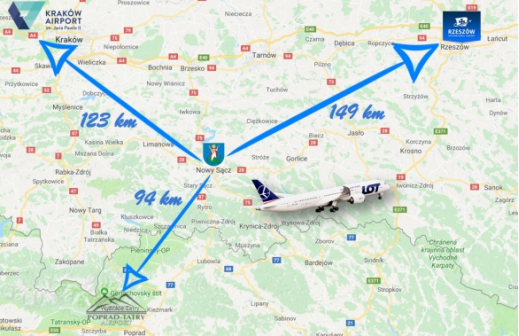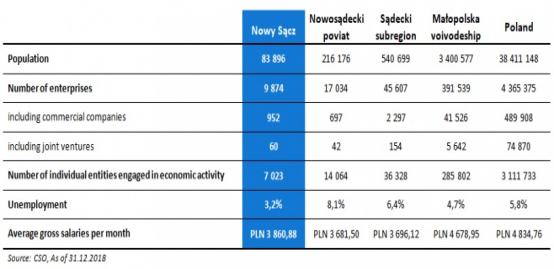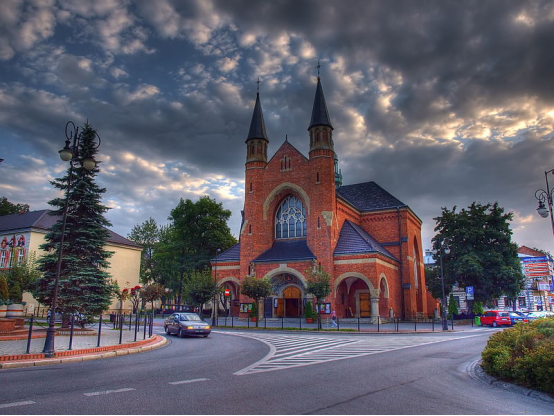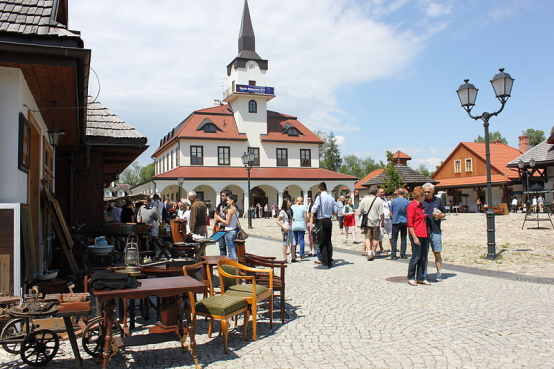Nowy Sącz- Lesser Poland 作者: 来源: 发布时间:2021-05-20
Ⅰ. Population and Area
Population (31.12.2018)
• Total 83,896 Decrease (44th)
Area
• Total 57 km2 (22 sq mi)
- Website
http://www.nowysacz.pl
Ⅱ.Natural Geography
Nowy Sącz is located at the confluence of the Kamienica River and Dunajec, about 20 kilometres (12 miles) north of the Slovak border, in the Sądecka Valley (Kotlina Sądecka) at an altitude of 381 metres (1,250 feet). It is surrounded by ranges of the eastern Outer Western Carpathian Mountains: Beskid Sądecki to the south, Beskid Wyspowy to the west, Beskid Niski to the southeast, and the foothills of Pogórze Rożnowskie to the north. The geological basis is Carpathian flysch – an undifferentiated grey-banded sandstone – with alluvial sediment from the Dunajec, Poprad, and Kamienica rivers in the valley basin. The climate is temperate, with an average annual rainfall of about 700 millimetres (27.6 inches).
Nowy Sącz is the governmental seat of Nowy Sącz County part of the Lesser Poland Voivodeship, Województwo Małopolskie since 1999. Between 1975 and 1998 it was the provincial seat of Nowy Sącz Voivodeship. Before that and during the Second Polish Republic, Nowy Sącz was a county seat in the Kraków Voivodeship. In 1951 it became a town with the rights of a county. It is the historic and tourist centre of Sądecczyzna, the Sądecki district.
Transport

Roads
Nowy Sącz lies on the road from Kraków to Koszyce and Budapeszt, with national road No. 87 leading from Nowy Sącz to the border crossing point at Mnišek on Poprad.
The nearest motorway, the A4 at Brzesko, 55 km distant, is accessible by national road No. 75. An exit on the D1 motorway, about 90 km from Nowy Sącz at Poprad (Slovakia), can be reached by national road No. 87.
Good bus, train and city transportation make it easy to take trips to attractive places in the nearby Beskid Mountains, including the well known resorts of Kyrnica, Muszyna and Piwniczna. There are 45 city and suburb bus lines. The PKS bus service ensures travelling ease and pleasure and offers bus connections to Warsaw, Lublin, Lodz, Krakow, Katowice, Rybnik, Rzeszow, Przemysl, Zakopane and Bardejova (Slovakia). In the city there are two helicopter landing fields (near the hospital and in Biegonice).
Nowy Sacz lies at the intersection of two major communication routes: Wadowice - Przemysl no. 28, and Krakow - Krynica no. 75 (with a branch to Piwniczna - no. 87).
Nowy Sacz has direct railway connections with the largest cities of Poland (Warsaw, Krakow, Gdynia), and also with Budapest (Hungary) and Kosiyce (Slovakia). One can buy tickets at the railway station and it is possible to pay with AE, MC or VISA credit cards.
Housing Estates
The city has 25 housing estates: Barskie, Biegonice, Centrum, Chruslice, Dabrowka, Falkowa, Golabkowice, Gorzkow, Helena, Kaduk, Kilinskiego, Kochanowskiego, Milenium, Nawojowska, Pišakowa, Poreba Mala, Przetakowka, Stare Miaslcze and Zawada.
Border crossings with Slovakia
Leluchow - Circ (for everyone, road)
Piwniczna - Mniszek nad Popradem (for everyone, road)
Muszynka - Kurov (for locals, road)
Piwowarowka - Pilhov (for locals, road)
Muszyna - Plavec (for everyone, railway)
Invest in Nowy Sącz
banner graficzny banner graficzny banner graficzny banner graficzny banner graficzny banner graficzny banner graficzny banner graficzny banner graficzny
Ⅲ.Economy

Nowy Sącz : Oficjalna strona miasta - Investment offer https://www.nowysacz.pl/investment-offer#Air
During the Polish communist regime, Nowy Sącz was the capital of Nowy Sącz Voivodeship (1975–98). In the 1950s the Polish authorities applied a special economic programme for the town, called the Nowy Sacz Experiment. The plan was to provide improvement and acceleration of the region's economic development, but it was only partially completed. The town was an important centre of the railway industry, and now contains one of the biggest railway engineering works in Poland. Since the social and political changes in Poland that started in 1989, the industry has faced economic problems.
Nowy Sącz is also important in the food industry, specialising in processing fruits, especially apples. Most of the factories were in the Biegonice district. Now the local government is trying to change the structure of the industry, restructuring old factories and encouraging new companies to start up. This initiative also includes a move to the hi-tech industry. Nowy Sącz had one of the first computer companies in Poland, with the largest assembly plant in Europe, but this has closed due to ownership friction with the government. The building trade is also represented in the town, which has a major European window-manufacturer. Like all the bigger towns in Lesser Poland, it has seen a significant influx of the largest European grocery chains.
A main economic problem now is the high level of unemployment which, officially about 20%, is one of the highest in the European Union. Recently the local government has tried to address the persistent economic and social problems of the local Romani community, including access to utilities and education.
Ⅳ.Industrial Characteristics
Nowy Sącz belongs to a group of economically unspecialised towns. It has however clearly outlined commercial activities as well as equally well-developed non-market services, mainly in the fields of administration and healthcare. The transport sector is relatively important, as are construction and processing industry.
Key project
1. "Nowy Sącz Development Strategy 2020+".
Nowy Sącz : Oficjalna strona miasta - Investment offer https://www.nowysacz.pl/investment-offer#Air
2. Nowy Sącz Northern Bypass
A road of GP class joining DK 75 (crossroads of Tarnowska and Witosa Streets) with Marcinkowicka Street (district road No. 25219) within Nowy Sącz linking to DK28 - Zator - Przemyśl The cost of over 2 km section of road is 98 million PLN
Nowy Sącz : Oficjalna strona miasta - Investment offer https://www.nowysacz.pl/investment-offer#Investments
3. Stage II of the reconstruction of Broniewskiego Street.
On Thursday, August 27, only traffic from the section of the street from Barska Street to the intersection with ul. Batalionów Chłopskich (along with the intersection of Broniewskiego, Batalionów Chłopskich, Okulickiego Streets). The restrictions do not apply to access to the property located on the section in question.
Nowy Sącz: The official website of the city - Poland https://www.nowysacz.pl/pl
Ⅴ.Attrations and Cityscape

St. Casimir Church

Reconstruction of the Galician town at the Sądecki Ethnographic Park
The city has many historic features, including one of the largest marketplaces in Europe after Kraków, along with one of the largest old squares in Poland; the late 19th century Ratusz (city hall) is centred in the square. Other points of interest include:
Saint Margaret's basilica, Bazylika kolegiacka Św. Małgorzaty (15th century). The coat of arms shows St. Margaret and a dragon; her name day is July 20.
A 15th-century house Dom Gotycki containing a regional museum.
A gothic Franciscan church.
The Great Synagogue, dating from 1746, now the Galeria Dawna Synagoga, a gallery with some historical displays. There is a memorial tablet on the front in Polish, Hebrew, and Yiddish. Across the Kamienica River is the Jewish cemetery.
Saint Roch, a church of wooden construction from the 15th century, in the Dąbrówka district. The old cemetery chapel St. Helen's Church is another example.
The partially restored ruins of a mediæval Royal Castle from the 14th century during the reign of Kazimierz the Great. It was destroyed in 1945 at the end of World War II when it was used as a German ammunition store and was the site of mass executions. There are also the remains of the city walls nearby.
An open-air museum or skansen (Sądecki Park Etnograficzny), containing a village of relocated authentic structures recreating indigenous architecture, customs, and folk culture from the region. Of particular note are the wooden churches, including an Orthodox church and the Roma (Gypsy) village.
Stary Sącz (Old Sącz) 10 km (6 mi) to the south, founded in 1163 but smaller than Nowy (New) Sącz, has a charming cobbled market square, with a convent of Poor Clares to the east.
There are also several routes emphasising wooden churches in the region of note.
The mountainous country around Nowy Sącz is also popular with tourists, hikers and skiers, especially the Beskid Sądecki mountains (part of the Carpathians), of which the highest peak is Radziejowa (1,262 m (4,140.42 ft) above sea level). Nearby popular mountain resorts include Krynica-Zdrój and Piwniczna-Zdrój ("Zdrój" means "health spa"). 15 km (9 mi) north of Nowy Sącz is Lake Rożnów (Jezioro Rożnowskie), a reservoir (22 km (14 mi) long, covering an area of 16 km2 (6 sq mi), and having a capacity of 193,000,000 m³), with many dachas and camping sites. To the north of the lake is the Ciężkowice-Rożnów Landscape Park (Park Ciężkowicko-Rożnowski). An annual festival of dance featuring children from highland regions from around the world takes place in July.
Ⅵ.History and Culture
Nowy Sącz was founded on 8 November 1292 by the Bohemian king Wenceslaus II, on the site of an earlier village named Kamienica. The foundation of New Sandec took place due to the efforts of Bishop of Cracow, Pawel z Przemankowa, who owned Kamienica. Upon request of the bishop, Wenceslaus II granted it Magdeburg rights, making it the only Polish town founded by the Bohemian king. Its name was taken from the nearby town of Stary Sącz. As early as 1329, the name was spelled Nowy Sandacz.
In the 14th and 15th century Nowy Sącz emerged as one of the most important economic and cultural centres of this part of the Kingdom of Poland. The town benefited from its proximity on the trade route to Hungary due to privileges granted by King Władysław I the Elbow-high, and later his son, Casimir III the Great, for supporting him during the Rebellion of wojt Albert in 1311–1312. During these times, the majority of the town's inhabitants were German colonists. In the 15th century it produced steel and woollen products, and nearly rivalled Kraków in visual arts. In 1329, New Sandec signed a treaty with Kraków, upon which Kraków merchants, on their way to Hungary, had to stop at New Sandec; New Sandec merchants, on their way to Gdańsk, were obliged to stay at Kraków. In the mid-14th century, King Casimir the Great built a royal castle here and surrounded the town with a defensive wall. Nowy Sącz was the seat of a castellan and a starosta, becoming an important point in the system of defence of the southern border of Poland. The town was further elevated in 1448 when Bishop Zbigniew Oleśnicki promoted a local church to the status of a Collegiate.
Nowy Sącz prospered in the Polish Golden Age (16th century). It was an important centre of the Protestant Reformation. Local leader of the Polish Brethren, Stanisław Farnowski, was very popular among local nobility. Good times ended in the 17th century. In 1611 a great fire destroyed much of the town, and during the Swedish invasion of Poland, the town was captured by the Swedes (late 1655), who burned and looted it. Nowy Sącz was a centre of the rebellion against the invaders.
Partitions of Poland
Nowy Sącz in the 1840s
The decline of the town continued in the 18th century, when Nowy Sącz suffered more destruction during the Great Northern War and the Bar Confederation, when the castle was burned. In 1772, during the Partitions of Poland, the town was annexed by the Habsburg Empire as part of Galicia, where it remained until November 1918. Nowy Sącz rose to new prominence in the 19th century when the Austrian authorities built a railway connecting it with Vienna (1880s). New Sandec was the seat of a county, new buildings were opened, the town was a rail hub with a large rail repair shop opened in 1876.
On April 17, 1894, the central part of Nowy Sącz burned in a fire, with a town hall and ancient town records. At that time, the town was important in Hasidic Jewish history for the founding of the Sanz Hasidic dynasty during the 19th century, the precursor to the Bobov dynasty founded in nearby Bobowa (with a synagogue with occasional services by Cracow congregation) and the Klausenberg dynasty.
At the beginning of World War I, Nowy Sącz was occupied by the Russian Army. The Russians were driven back by the Central powers in December 1914. Briefly, after the end of the war, it was associated with the short-lived independent Lemko Rusyn People's Republic, established by members of the Lemko (a subgroup of ethnic Rusyns native to the Beskid Niski). The inter-war Poland saw industrial expansion and the railway factory expanded. In 1936, the Museum of Sandec Land was opened in the restored royal castle, and in 1939, the population of New Sandec was 34,000.
During the invasion of Poland starting World War II, Nowy Sącz was occupied by Nazi Germany on 6 September 1939. Because of its proximity to Slovakia, it lay on a major route for resistance fighters of the Polish Home Army. The Gestapo was active in capturing those trying to cross the border, including the murder of several Polish pilots. In June 1940, the resistance rescued Jan Karski from a hospital there, and a year later 32 people were shot in reprisal for the escape; several others were sent to concentration camps.
The regional Jewish community numbered about 25,000 before World War II, and nearly a third of the town's population was Jewish; ninety per cent of them died or did not return. The Nowy Sącz Ghetto for around 20,000 Jewish people was established by the German authorities near the castle. Its inhabitants were deported aboard Holocaust trains to Belzec extermination camp over three days in August 1942 and murdered. Across the river in the Jewish Cemetery, 300–500 Polish people were executed for their participation in the sheltering of Jews. The Red Army fought its way into the city on 20 January 1945. At war's end, about 60% of the city had been destroyed. Nowy Sącz was honoured for its heroism with the Cross of Grunwald, third class in 1946. In 1947 much of the Lemko population, living in villages southeast of the town, was deported in Action Vistula (mostly to land recently annexed from Germany) in reaction to the nationalist Ukrainian activity in the region.
Ⅶ.Other Information
A city of knowledge and creative people
Building its brand, the city's hosts use the slogan: "Nowy Sącz - the city of knowledge and creative people". On the asset side, at the top of the list, they enter its inhabitants, in the following order: location - a convenient point of contact with countries from southern Europe, a good atmosphere for entrepreneurs and doing business here, municipal infrastructure, cultural and tourist offer for residents and guests, friendly natural environment and investment plans important for the city, inhabitants of Nowy Sącz and guests, for its position in Małopolska.
Visitors and residents of Nowy Sącz recently say straightforwardly: this is not the same city as it was a few years ago. Changes can be seen almost at every step. Nowy Sącz, especially in the last two years, has become more beautiful and you can see the hand of the hosts in it!
Ⅷ.Contact Information
-Mayor Ludomir Handzel
-Website http://www.nowysacz.pl
-Urząd Miasta Nowego SączaRynek 1, 33-300 Nowy Sącz
- +48 18 443 53 08, +48 18 44 86 500,
- +48 18 443 78 63
- urzad@nowysacz.pl
